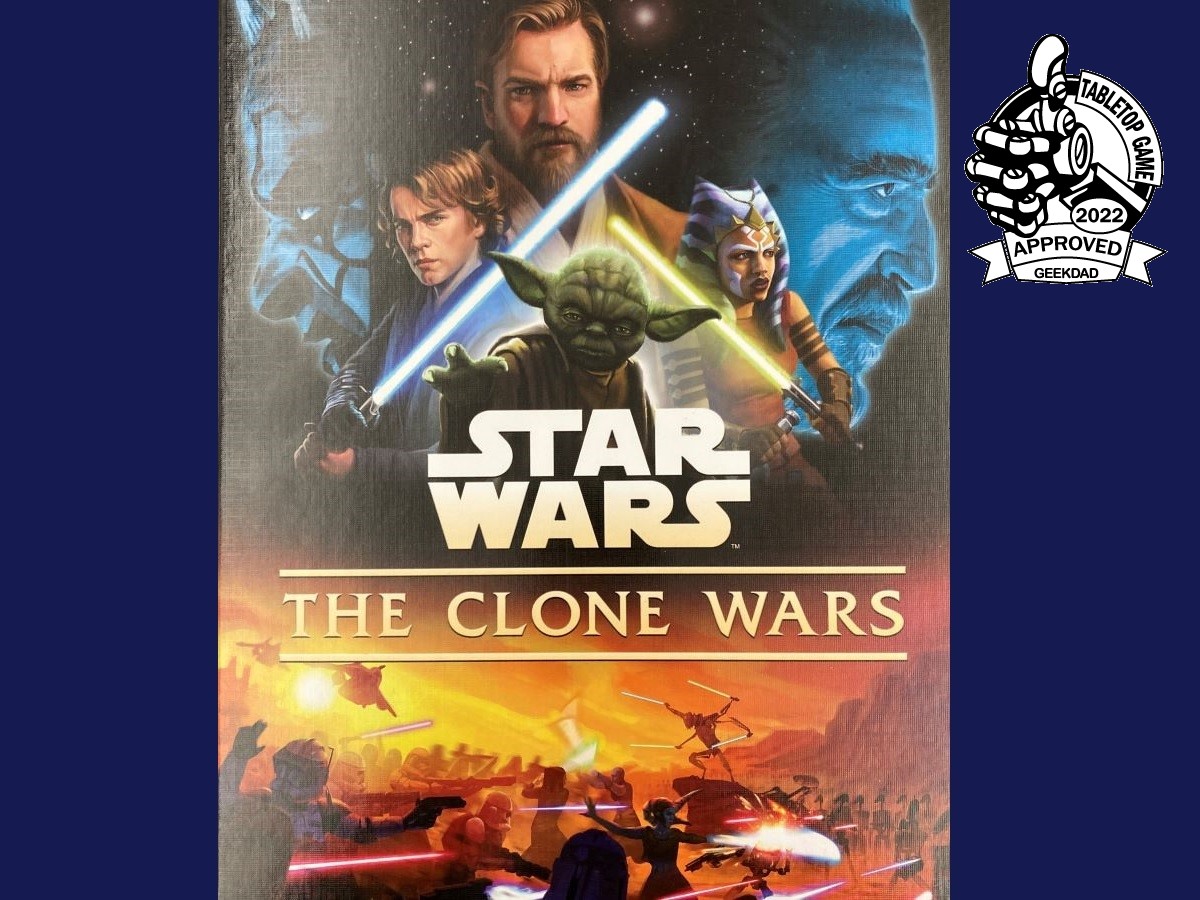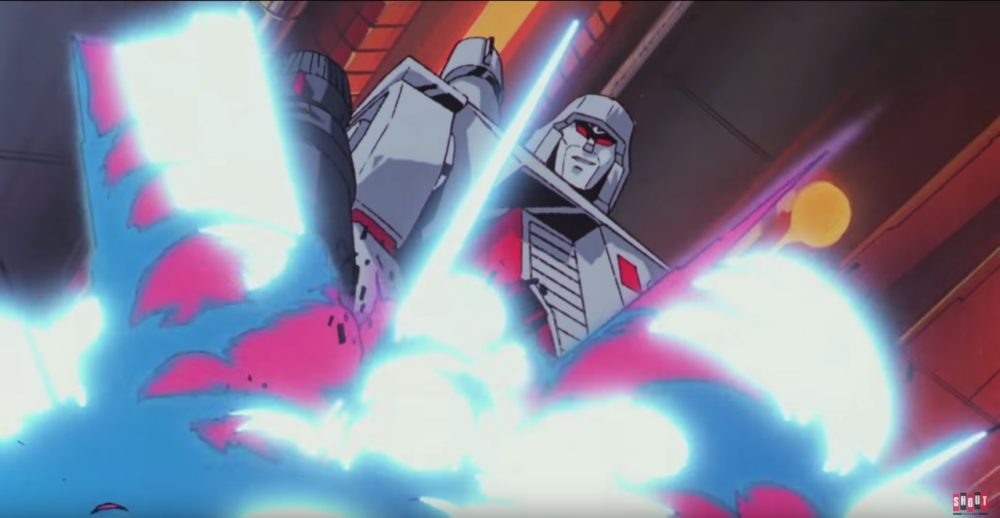In Star Wars Episode IV: A New Hope, Ben Kenobi told Luke Skywalker that he had served with Luke’s father during the Clone Wars. This single comment would be the focus of speculation for Star Wars fans for years until the release of Star Wars Episode II: Attack of the Clones when the Clone Wars actually begins. Many stories have been told in books, comics, television series, movies, and even video and tabletop games about this galactic conflict. Now you can take on the role of a Jedi general as you command your clone troops against the Separatist droid armies in Star Wars: The Clone Wars–A Pandemic System Game.
What Is Star Wars: The Clone Wars?
Star Wars: The Clone Wars is a cooperative game for 1-5 players, ages 14 and up, and takes about 60 minutes to play. It’s currently available at Target, your FLGS, and from Amazon, selling for $59.99 for a copy of the game. Star Wars: The Clone Wars was designed by Alexander Ortloff, with the original Pandemic game design by Matt Leacock. The game is published by Z-Man Games, with graphic design by Jasmine Radue, Dan Gerlach, Monica Helland, and Samuel R. Shimota.
Star Wars: The Clone Wars Components
Here is what you get in the box:
- 7 Jedi miniatures
- 4 Villain miniatures
- 3 Blockade miniatures
- 36 Droid miniatures
- 1 Game board
- 1 Die
- 46 Squad cards
- 32 Invasion cards
- 7 Jedi cards
- 4 Villain sheets
- 23 Villain cards
- 24 Mission cards
- 2 Track markers
- 2 Mission markers
- 1 Reminder marker
- 1 Solo marker
- 1 Slider
- 5 Reference Cards
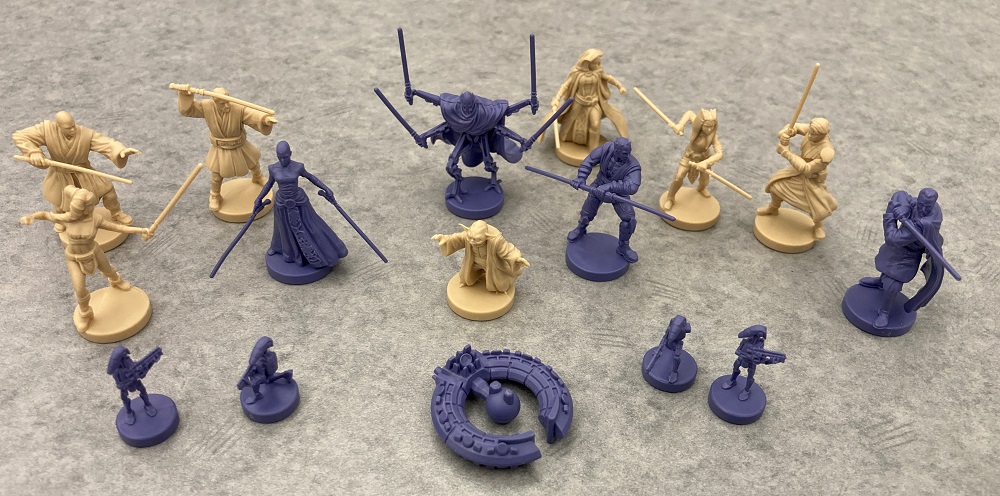
The Jedi miniatures represent the player’s characters during the game while the Villain miniatures show the location of the leaders of the Separatist forces. Droids are placed on planets to show the amount of control the Separatists have in that system while the Blockade miniatures in the shapes of Trade Federation battleships show when a system is under blockade.
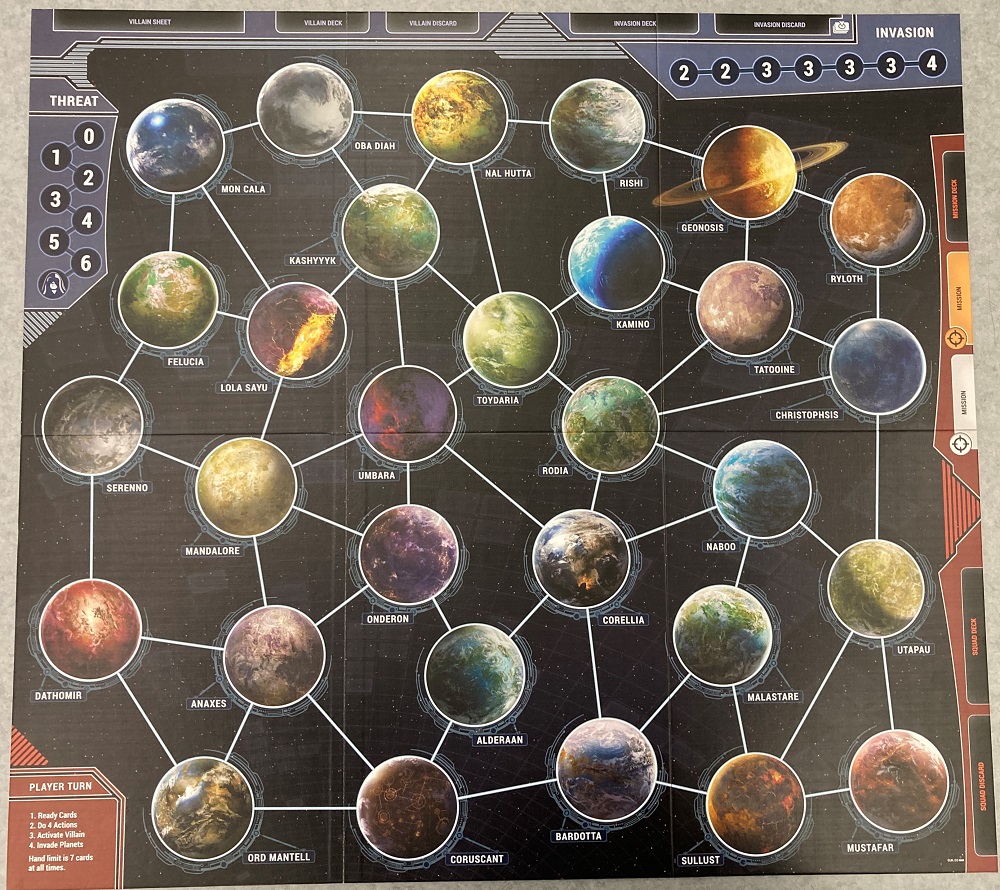
The game is played on the game board which features 30 different planets representing systems of the galaxy. A threat track and invasion track are located in the upper left and upper right corners respectively and tabs along the top and right sides show where cards can be placed during gameplay.
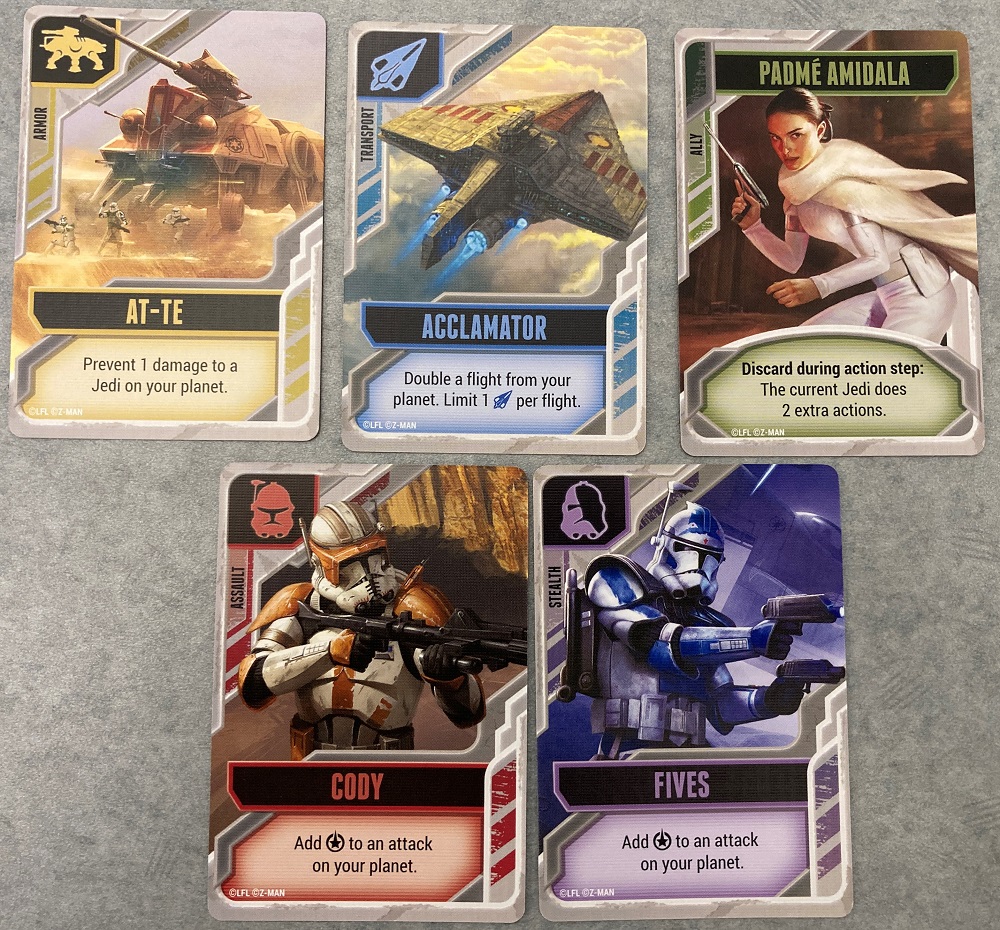
The Jedi use squad cards as their army. There are five different types of squad cards. Assault and Stealth cards are clone troopers who add success to your attacks. Armor can be used to prevent damage while transports allow you to move twice during a flight action. Finally, Ally cards are discarded to provide useful effects.

Invasion cards are used to determine which systems the Separatists will invade next. The show an image of the planet as well as a small map with the location of the planet on the game board as a reference.
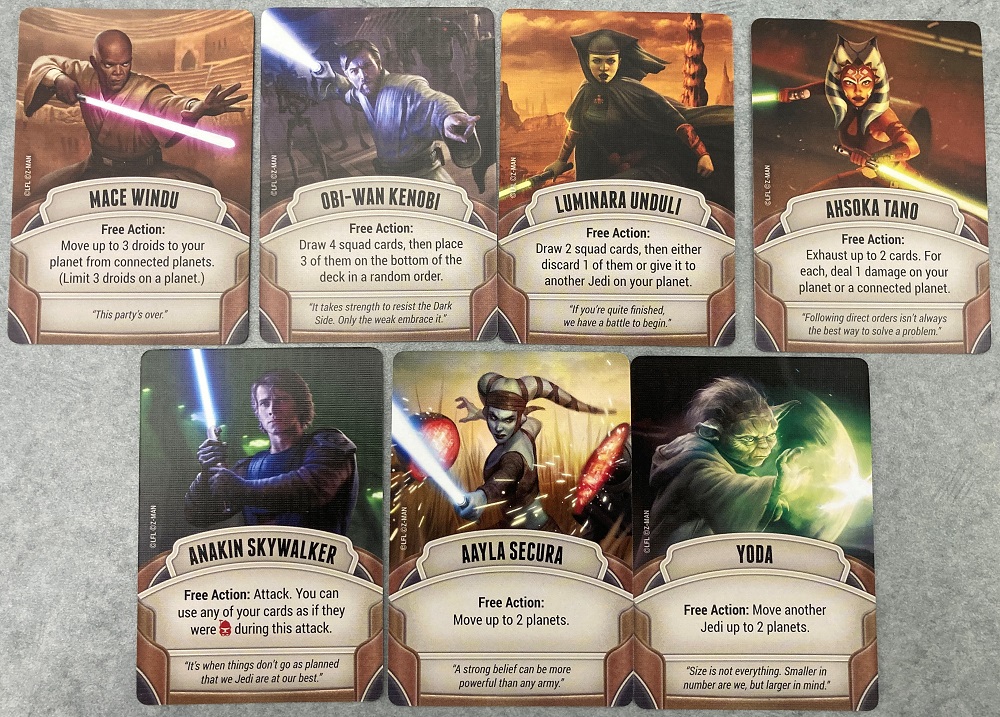
Each player takes on the role of a Jedi. The Jedi cards are used to show which Jedi you are playing as well as lists that Jedi’s special ability. This ability is a free action you can do only once during the actions step, but does not count as one of your four actions.

Each Villain has a sheet with two sides. The first side lists the Villain’s health and any special effects they have on the game. The other side is used during the Finale and lists the requirements the players must complete in order to win the game.
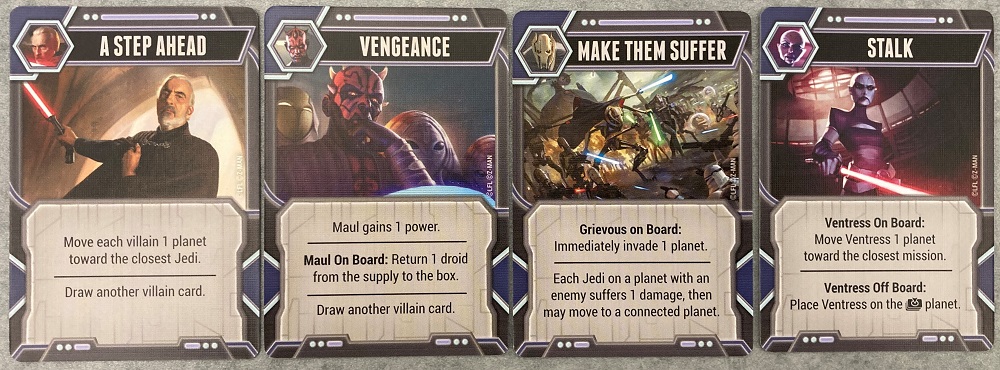
Villain cards are drawn and resolved during the Villain step and have one or more effects that take place when they are drawn. Each Villain has their own deck of personalized Villain cards.
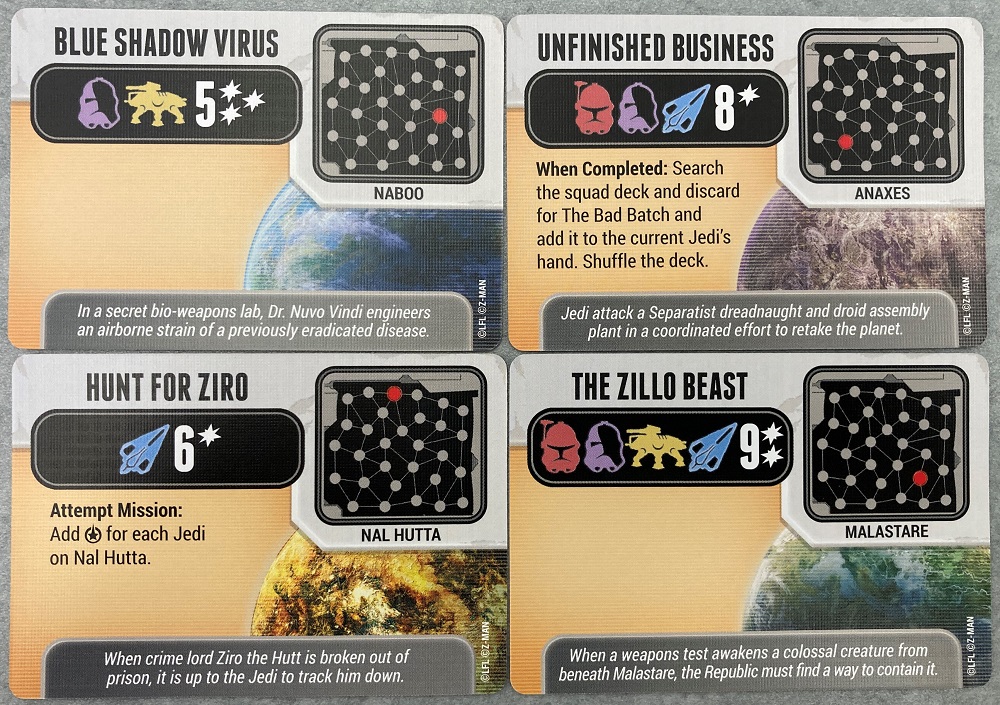
Three or more mission cards are selected at the star of the game. The players must complete all of the missions in order to advance to the Finale. Each mission card lists a location where the mission must be performed as well as the number of successes required to complete it and any damage taken as a result.

The die is used to resolve attacks and during mission attempts. The two symbols on the faces of the die represent successes and damage taken. The blue markers are used to track threat and invasions while the mission markers are placed on the systems where missions are currently active. Some Villains have an effect that takes place during their step, so a reminder marker is used to remind players of this effect. Finally, the solo marker is used in solo games to keep track of which Jedi is currently active.
How to Play Star Wars: The Clone Wars
You can download a copy of the rulebook here.
The Goal
The goal of the game is to complete the Finale on the back of the Villain sheet before the threat marker reaches the bottom of the threat track.
Setup
Start off by placing the game board in the center of the play area. Place the droid and blockade miniatures next to the board. Next choose a villain and place their villain sheet on its non-finale side at the top of the board where indicated. Shuffle the matching 6-card villain deck and place it face down next to the villain sheet where the board has a space. If the villain sheet has an effect with an ‘!’ next to it, place the reminder marker on top of the villain deck to remind you to do the effect each turn. Then follow any setup instructions on the villain sheet.
Now to set up the invasion deck and complete the initial invasions. Take the two ‘Mission Planet’ invasion cards and place them faceup near the invasion discard indicator. Then shuffle the invasion deck and place it facedown near the invasion deck indicator. Draw the first two cards and place three droids on each of the matching planets. Then draw two more cards and place two droids on each of those planets. Finally draw two additional cards and place one droid on each planet with the villain miniature on the planet of the last card drawn. Place all six revealed invasion cards faceup in the invasion discard pile.
It is time to get the Jedi ready. Each player chooses one Jedi card and takes the matching miniature. Shuffle the reference cards before dealing one to each player. Players then place their Jedi miniature on the planet on the back of their reference card. Any remaining Jedi cards, miniatures, and reference cards are then returned to the box. In order to prepare the squad deck, shuffle the squad cards and place them face down near the squad deck indicator. Deal 3 squad cards to each player for 2- or 3-player games or four squad cards for 4- or 5- player games.
Next build the mission deck. The number of mission cards in the deck determines the difficulty level of the game. For example, the easiest level, Padawan, only has three mission cards while other levels can have 4, 5, 6, or more cards. Shuffle the mission cards and draw the determined number face down and place in them near the mission deck indicator. Return the remaining mission cards to the box without looking at them. From the mission deck, draw the top two cards and place them next to the orange and white mission indicators. Place the orange and white mission markers on the corresponding planets. Finally give the die to the player with the high ground. They will go first.

Gameplay
Players take turns in a clockwise order. Each turn is divided into four steps: ready cards, do 4 actions, activate the villain, and invade planets. Let’s take a look at each step individually.
Ready Cards
During the course of the game, your squad cards may become exhausted after you play them. This is indicated by rotating the card sideways. For this step, the current player readies all their exhausted cards by turning them upright.
Do 4 Actions
During your turn you can take up for four actions. There are four different actions and you can take the same action multiple times, though each time they count as one of your actions.
The Fly action allows you to move your Jedi to a connected planet. The presence of enemies, whether droids, blockades or villains, does not affect your movement.
The Reinforce action allows a player to draw one squad card. Squad cards are always placed face up in front of the owning player so that everyone can see each other’s hand. Each player can have a maximum of 7 cards in their hand. Even if you have 7 cards in your hand, you can still use the reinforce action. After drawing an eighth card, you need to discard a card from your hand. This can even be an exhausted card.
The Attack action allows you to remove enemies from the planet where your Jedi is currently located. When you attack, roll the die and for each success shown on the die, deal one damage to an enemy on the planet. Droids have 1 health while blockades have 2 health. Villains’ health are shown on their sheet. If an enemy suffers damage equal to its health, it is removed from the board and returned to the supply or in the case of a villain, back to its sheet. Damage is not carried over between actions, so all damage must be inflicted during a single action. You can play squad cards in order to apply additional damage to your attack. Both assault and stealth squad cards can add one damage to your attack. You can play as many as you want, but must choose either assault or stealth. You can’t combine them in a single attack. However, you can use assault cards during one attack action and then your stealth cards during a different attack action on the same turn. If a damage symbol is rolled on the die as part of the attack, you must suffer the damage by discarding one squad card (exhausted or ready) for each damage. The armor squad cards can each absorb one point of damage by exhausting them so you can avoid having to discard.

If your Jedi is on a planet with one of the mission markers, you can do the Attempt Mission action so long as their is not a blockade or villain on that planet. To do this, roll the die and then play squad cards. If another Jedi is on the same planet, they can also play their squad cards to help complete the mission. A mission card will list the number of successes required to complete it as well as which types of squad cards can be used to contribute to the die roll. If there are multiple squad symbols, you can use all cards of those types. Once the mission has been completed, then the current Jedi suffers one damage for each damage located on the mission card as well as the die roll. Some missions also have an effect when completed that must be resolved. Remove the mission card and return it to the box. Then draw the top mission card from the deck and place it in the empty slot. You may need to complete a ‘when drawn’ effect. Then move the mission marker of the matching color to the planet shown on the new mission. If there are no more mission cards in the deck, then place the mission marker on the location of the remaining mission so that planet will then have both markers. If the Jedi fails to complete a mission, the current Jedi suffers only the damage on the die and not on the mission card.
Each Jedi card also lists a special ability which is a free action that can be taken only once during your actions step and does not count toward one of your four actions. It cannot be used in the middle of an action or during another player’s turn.
Activate the Villain
After a Jedi has completed their four actions, it is the villain’s chance to strike back. If the villain has an effect listed on their sheet that occurs every turn, resolve that effect first. Then draw one villain card and resolve it. If there are multiple effects on the card, start at the top and resolve each effect in order, skipping any effects that can’t be resolved.
Invade Planets
The final step of a turn involves invading planets. Check the current invasion rate and then flip over that many cards from the top of the invasion deck. Place one droid on the planet shown on each card. If a planet already has three droids on it, then advance the threat marker one space and place a blockade on the planet. A single planet can have multiple blockades on it. If you ever have to place a droid or a blockade and there are no more in the supply, then advance the threat marker once for each droid or blockade you would need to place.
Game End
The game ends in a defeat for all players if the threat marker reaches the bottom space of the threat track. The players all win if they complete all the mission in the deck and complete the finale on the back of the villain sheet. The finale starts when all mission have been completed. Once the finale begins, you ignore what is on the front of the villain sheet and only follow the directions on the finale side. Each villain has one or more missions that must be completed by players in order.
Star Wars: The Clone Wars–A Pandemic System Game is GeekDad Approved!
Why You Should Play Star Wars: The Clone Wars
I enjoy cooperative games and have been a big fan of Matt Leacock and his Pandemic system. On top of that, I love Star Wars, so it was a given that I was excited when I heard about Star Wars: The Clone Wars–A Pandemic System Game. After playing this game, I can attest that I was not disappointed. The quality of the components is top notch. The Jedi and villain miniatures are detailed and even the droids and blockade miniatures look good. The markers are made of plastic with printing on them rather than cardboard counters and the cards are colorful and easy to understand. I also like how the gameboard has indicators along the edges showing players where to place the various decks of cards and discards. This helps keep the play area neat and organized.
While the physical presentation of the game is great, the gameplay is equally impressive. I like the use of squad cards for the Jedi players to use as their armies. They can be exhausted to use their abilities and are discarded when damage has been inflicted on you. These cards work great with the ability to take four actions each turn. Exhaust a transport card so you can move a Jedi twice with one fly move, use your assault and stealth cards to inflict more damage during an attack, and absorb damage with your armor cards to avoid discarding cards. Maintaining a good variety of squad cards is an important strategy for the game and you may need to use the reinforce action to get new cards and prepare for future battles as well as the missions.
Since there are 24 different missions, you can easily have different challenges each time you play. The missions are all based on episodes from the Star Wars: The Clone Wars animated series. Therefore, many of the names of the missions will look familiar. In addition, you can determine the difficulty level of the game by the number of mission cards you decide to use. The combination of missions will often have your Jedi racing across the galaxy to complete them as well as clearing out invasions to prevent blockades.
The Jedi and villains really add a lot to the game. Each Jedi’s special ability acts like a free action. Obi-wan’s ability lets you draw 4 squad cards, keep one and return the other 3 to the bottom of the deck. This free reinforce action gives you a better chance to find a squad card you need. Anakin has an attack action that lets you use any of your squad cards as if they were assault cards, making him great for clearing out blockades and droids as well as villains. Yoda can move another Jedi up to two planets which can be useful to bring that Jedi to a planet with a mission so Yoda can work with them to complete the mission. The four villains also each have a unique flavor with their different abilities as well as villain cards that follow a different strategy to try to defeat the Jedi. I really like the finale for each villain since they really increase the tension of the game as the Jedi must really work together to complete the requirements to win.
I am very impressed by Star Wars: The Clone Wars–A Pandemic System Game. It does a wonderful job of taking the Pandemic system and modifying it to a galactic war where Jedi fight droid armies rather than specialists taking on pathogens. Those who have never played a Pandemic game will still enjoy it because Star Wars: The Clone Wars stands on its own merits. Since the rules are fairly simple, this game is quick to learn and easy to teach. Plus it really does a great job of applying the Star Wars theme with Jedi generals leading clone armies against deadly villains. The game also offers a lot of replayability with unique villains and lots of different missions. Star Wars: The Clone Wars–A Pandemic System Game has earned our GeekDad Approved award for all of the many reasons I have listed here. I really enjoy playing this game and highly recommend it, especially if you are a fan of Star Wars.
For more information visit the Star Wars: The Clone Wars webpage! Here is a quick trailer for the game.
Click here to see all our tabletop game reviews.
![]() To subscribe to GeekDad’s tabletop gaming coverage, please copy this link and add it to your RSS reader.
To subscribe to GeekDad’s tabletop gaming coverage, please copy this link and add it to your RSS reader.
Disclosure: GeekDad received a copy of this game for review purposes.
